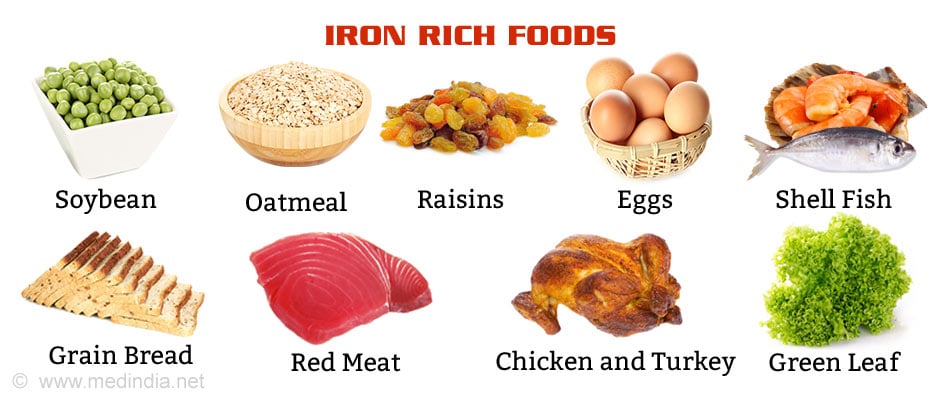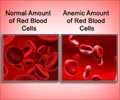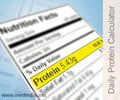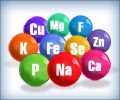Iron Intake Calculator will guide you to find daily iron requirement to prevent anemia and you can also choose from the suggested list of
iron rich foods.
Are you suffering from fatigue, tiredness, dizziness, lack of concentration, looking pale, getting soreness of mouth with cracks at the corners or craving for non food items like dirt, paper, ice? If you have some or all these symptoms, you most likely have
‘Iron Deficiency Anemia.’Iron is an essential mineral needed for growth and development of human body. It helps in muscle and blood cell formations. Iron is essential for hemoglobin production in red blood cells (RBC) which helps in oxygen transport. Lower iron levels, leads to scanty and smaller red blood cells production.
This reduces the oxygen carrying capacity of RBCs which leads to the above symptoms. Iron’s function in myoglobin (muscle cells) is to store and release oxygen within muscle cells. Iron is also necessary to maintain healthy cells, skin, hair, and nails. Anemia can decrease immunity which increases risk of infection.
Forms of Iron Present in Human Body
About 70% of iron is present in hemoglobin and myoglobin, 6% in other essential proteins. 25% of iron in ferritin form is stored in hemoglobin.
Iron is present in human body in various forms. Hemoglobin is the most common and abundant form of iron present in humans. 15% iron is present in myoglobin in muscle cells.
Iron is stored in humans as ferritin and hemosiderin in
liver,
spleen,
bone marrow and
skeletal muscles (
1✔). Ferritin and hemosiderin act as iron reserves. The total amount of body iron stores is around 600 to1000 mg in the normal adult male and around 200 to 300 mg in the normal adult female. Ferritin is released when iron is low, so ferritin level test helps in diagnosis of
iron deficiency. Hemosiderin a complex iron form, that is formed when
red blood cells rupture and it is present in macrophages. This form of iron is also stored when the ferritin storage is exceeded and it will not be released when iron is low.
Dietary Iron Form
Iron is available in two
dietary forms. They are Haem iron food and Non-haem iron food. Iron cannot be synthesized by the body, but can be recycled and reused by macrophages from dead RBCs (
2✔).
Haem Iron foods are found in animal-based food items, like
red meat,
poultry and
fish. Haem iron is easily absorbed by the body. We absorb approximately 15-35% of the haem iron we eat.
Non-Haem Iron foods are found in plant-based foods like
cereals,
vegetables and
legumes. In contrast to haem iron, our body doesn’t absorb non-haem iron as easily. Only 2 - 20% of non-haem iron is absorbed.
Iron for pregnant women
Iron regulates a healthy immune system. Pregnant women need more iron for the growing fetus and
placenta. Iron is most essential during the second and third trimester of
pregnancy. Pregnant women need 27 mg of iron per day. Iron-deficiency anemia during pregnancy is associated with
preterm delivery, low birth weight, and infant mortality. To avoid these conditions, WHO recommend to take 30-60 mg iron along with 400 µg of folic acid (
3✔) . Absorption of iron from non-haem food is ineffective compared to haem foods. So vegetarians are adivised to take more of non haem iron foods to meet the iron requirement during pregnancy.
Iron Requirement during Lactation
During
lactation, the Recommended Dietary Allowance (RDA) for iron for women aged 19–50 is 9 mg per day, the same as for non-pregnant, non-lactating women of the same age group. Lactating women of age less than 18 years need 10 mg iron per day. The baby is born with enough reserves since milk is not a good source of this nutrient.The additional iron in the mother's diet during lactation are important for mother's health.
Recommended Iron Intake
| Life Stage (Age) | Recommended Amount |
| Birth to 6 months | 0.27 mg |
| Infants 7–12 months | 11 mg |
| Children 1–3 years | 7 mg |
| Children 4–8 years | 10 mg |
| Children 9–13 years | 8 mg |
| Teen boys 14–18 years | 11 mg |
| Teen girls 14–18 years | 15 mg |
| Adult men 19–50 years | 8 mg |
| Adult women 19–50 years | 18 mg |
| Adults 51 years and older | 8 mg |
| Pregnant teens | 27 mg |
| Pregnant women | 27 mg |
| Breastfeeding teens | 10 mg |
| Breastfeeding women | 9 mg |
Source (
6✔).
Iron Deficiency
Iron deficiency leads to
anemia. Iron deficiency is most commonly caused due to excess bleeding,
iron deficient diet, body’s inability to absorb iron. Iron ingested is absorbed in the
small intestine in very small amount(
4✔).
Who is at the Risk of Iron Deficiency?
Symptoms of Iron Deficiency Anemia
These symptoms are related to decreased oxygen carrying capacity of hemoglobin.
The symptoms are
Iron deficiency can be treated with balanced diet, iron supplements and by ingesting the correct level of iron daily.
Iron Supplements
Iron supplements/ are available in capsule, tablet, chewable and liquid form. The most common available size is 325mg (5✔).
Iron is best absorbed in empty stomach but it may cause stomach cramps, ulcers. Iron must not be taken with milk, calcium tablets or antacid as they can interfere with each other absorption.
Constipation, nausea, vomiting are most common side effects of taking iron. Black stools are normal with iron supplements.Iron Overload
Primary Iron Overload is due to hereditary condition. Hereditary hemochromatosis is the most common iron overload where body absorbs more iron which it cannot excrete. Iron overload can lead to various organ damage, infection and immune system impairment.
Important facts on iron deficiency anemia:
- Recommended Dietary Allowance (RDA) of 9 mg/day for adult men and 18 mg/day for teenage and adult females.
- A deficiency of iron limits oxygen delivery to cells, resulting in fatigue, poor work performance, and decreased immunity.
- Excess amounts of iron can result in toxicity and even death.
- Iron deficiency anemia can affect the function of numerous organ systems. It is the final stage of iron deficiency.
- The World Health Organization (WHO) estimates that approximately half of the 1.62 billion cases of anemia worldwide are due to iron deficiency.
- In United States approximately 16% of teenage girls aged 16-19 and 12% of women aged 20-49 are deficient in iron.
- Young children and pregnant women are at higher risk of iron deficiency because of rapid growth and higher iron needs.
- Adolescent girls and women of child bearing age are at risk due to menstruation.
- The most common tests for screening are Haemoglobin test and Haematocrit test.
FAQ's
1. What does low iron saturation mean?
Iron saturation refers to the amount of iron present in the blood. Low iron saturation indicates a low amount of iron in the blood. It can be caused by a number of factors, including pregnancy, heavy menstruation, frequent bleeding, certain genetic or gastrointestinal disorders and, impaired absorption (7✔).
2. How is iron lost from our body?
Iron is lost through sweat, shedding of intestinal cells and blood loss. Most common reason for iron deficiency in women is due to excess blood loss during periods (8✔).
3. When is the best time to take iron supplements?
Iron is best absorbed when taken on an empty stomach, with water or fruit juice, about 1 hour before or 2 hours after meals. However, to lessen the possibility of stomach upset, iron may be taken with food or immediately after meals (9✔).
4. Which food increase iron absorption?
Vitamin C is known to help in iron absorption. Hence it is advised to take iron rich food with food rich in iron like orange, amla or gooseberry, grapefruit, kiwi (10✔).
5. Does milk reduces iron absorption?
Milk contain non haem iron, and it high in casein and calcium content which interferes in iron absorption in the intestine (11✔).
6. How long does it take to treat iron deficiency anemia?
If iron deficiency is low level it can be treated with diet modification. If iron deficiency is severe it is treated through blood transfusion. It takes about 1 to 3 months of iron therapy based on iron level and severity (12✔).
7. Can iron supplements be harmful?
Yes, iron can be harmful if you get too much. In healthy people, taking high doses of iron supplements (especially on an empty stomach) can cause an upset stomach, constipation, nausea, abdominal pain, vomiting, and diarrhea (13✔).
8. Does iron interact with medication?
Yes, iron supplements can interact or interfere with medicines and other supplements. It interferes in medication which are used to treat hypothyroidism,parkinson’s disease and calcium containing drugs (14✔).
9. Which form of iron is easily absorbed?
Heme form of iron which is present in animal based food like meat, fish are easily absorbed than plant based iron foods (15✔).
10. How is iron stored in our body?
Iron is stored in spleen, liver, large intestine and bone marrow in form of ferritin and hemosiderin (16✔).












Hi all, Calculator shows me, i should take less iron than regular woman. I am lactating. Should i take less iron as lactating woman than counterparts who doesn't lactate? Is it a kind of bug in Calculator?